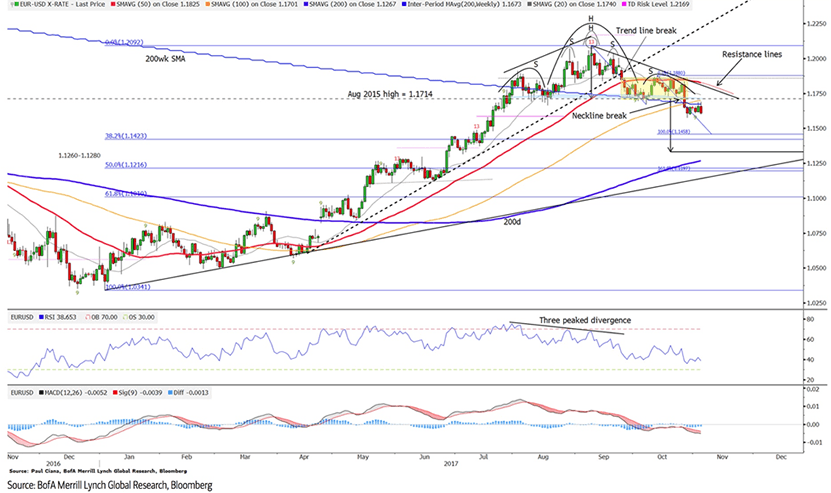Euro-Dollar: Head + Shoulders Pattern Dominates Outlook
- Written by: James Skinner

Strategists are taking note of a particular pattern on the Euro-to-Dollar exchange rate's charts that advocates for further downside.
The Euro could see a further sharp fall against the Dollar over the coming days and weeks, according to strategists, who are eyeing a return to levels not seen by the common currency since June.
A combination of Dollar strength, ECB-inspired Euro weakness and technical factors mean the Euro-to-Dollar pair is now vulnerable to continued declines.
“EUR/USD’s head and shoulders top has been followed by a bear flag pattern – this is very negative price action,” says Karen Jones, a technical analyst at Commerzbank.
Europe’s ‘single currency’ has been under pressure since the European Central Bank took a less aggressive approach to winding down its quantitative easing (bond buying) program than some had been hoping for.
The weakness has manifest itself in such a way as to turn the market structurally negative - i.e. some traders may now base buy-sell decisions on the exchange rate according to the technical setup they observe.
In a week where the Eurozone economic calendar is devoid of market-moving releases, technicals could prove all the more decisive.
“The measurement down from the head and shoulders top pattern 1.2092-1.1662, is 1.1232,” says Jones. “Given the close proximity of the 200 day ma at 1.1272 we will make this our downside target.”
Jones is holding a small short position in EURUSD, with an entry around the 1.1780 level, a stop loss at 1.1800 and a target at 1.1300.
“The outlook remains negative while capped by the current October highs and early August high at 1.1858/1.1910,” the strategist notes.
Also eyeing the head and shoulders pattern is Bank of America Merrill Lynch's technical strategist Paul Ciana:
"The October range/right shoulder breakdown suggests EUR/USD should decline to at least 1.15 however the H&S top technically targets 1.1320."
The range breakdown also broke the neckline of a larger head and shoulders top, which we reported on in early October (Here), confirming spot could decline further.
On a technical basis, Ciana says he prefers to sell intraday rallies up to the declining resistance lines and would continue to carry a short position for the downtrend underway.
Nowotny Reminds Markets ECB is in No Rush to Exit Quantitative Easing
Traders' views of a dovish stance at the ECB were cemented Friday when governing council member Ewald Nowotny told an audience that September 2018 could see a more “clear-cut” path to a bond market exit being marked out by the ECB.
This is later than markets had been expecting the ECB to provide clarity on ending its quantitative easing programme: the sooner the programme is ended the more bullish the Euro outlook becomes.
Nowotny cited stubbornly low Eurozone inflation for his call, “this goal of 2 percent or 1.9 is something that will not be easily reached in the years to come.”
The ECB said, at the end of October, it will reduce the amount of bonds it buys each month to €30 billion (from €60 Bn) from January and that it will continue the program until September 2018 “or beyond”.
Markets had been expecting a hard September stop to the central bank’s activities in the bond market and so October’s announcement was seen as a so called “dovish tapering” of QE.
Meanwhile, Friday’s comments from Nowotny suggest at least some members of the governing council still expect quantitative easing to continue after the September stop date originally envisaged by the market.
“EUR/USD is vulnerable to a move lower towards its 200-day moving average (near 1.1245) because of the ECB’s more cautious monetary policy outlook and favourable progress on U.S. tax reform,” says Elias Haddad, a senior currency strategist at Commonwealth Bank of Australia.
As downside pressures have mounted on the Euro over recent weeks, upside pressures have built beneath the Dollar, which drew a boost through October from solidifying expectations of a December rate hike and hopes the Trump administration will succeed in efforts to cut taxes.
“In the short-term, the USD can edge higher because of favourable U.S. tax reform developments,” says Commonwealth Bank’s Haddad. “Beyond this short-term period of USD strength, the fundamental downtrend in USD is intact.”
Haddad forecasts that low US inflation, the potential for Washington’s tax reform drive to fall apart at the seams and changes in relative yields at the international level could soon conspire against the greenback.
“The next move in interest rates being higher in countries “other” than in the U.S. due to their improving economies and moderately rising inflation will have a greater appreciating impact on their exchange rates, than will the Fed lifting interest rates over 2017-18 on the USD,” the strategist writes, in a note Monday.
Haddad warns of a possible fall to the 1.1247 level in his morning note Monday.
Get up to 5% more foreign exchange by using a specialist provider by getting closer to the real market rate and avoid the gaping spreads charged by your bank for international payments. Learn more here.





